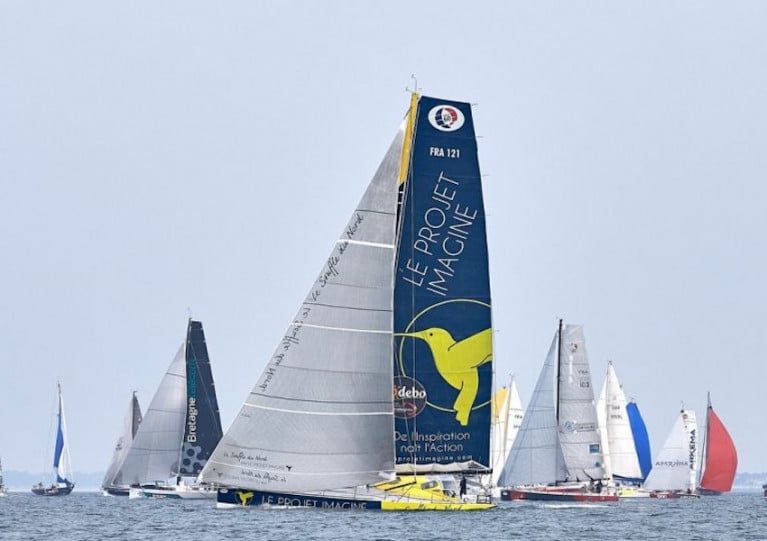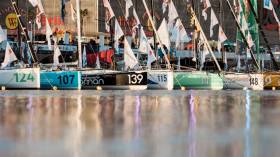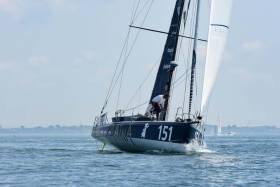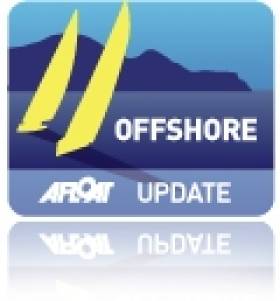Displaying items by tag: Class 40
The CIC Normandy Channel Race 2024, the highlight of the Class40 circuit, has extended its registration deadline to April 1 to accommodate the growing interest in the event. The 15th-anniversary edition of the race, scheduled for Sunday, September 15, 2024, is expected to feature thirty or more crews, with around 25 teams already signed up or showing interest.
The event, which is a qualifier for the 2nd edition of the GLOBE40 round-the-world race, is an opportunity for competitors to showcase their skills and craft in a constantly evolving circuit. The CIC Normandy Channel Race 2024 is the perfect platform for new owners, with an average of 50% of competitors being rookies. It is also an opportunity for recently launched craft, such as Ian Lipinski's new CREDIT MUTUEL (Max40.2) and the latest Mach.40.6, currently in build for American Greg Leonard.
The CIC Normandy Channel Race has hosted 591 skipper participations over the past 15 years, with an average of 21 Class40 per edition since 2010. The event is synonymous with limited logistical costs, a favourable carbon footprint, international media coverage, and various hospitality options for businesses.
The CIC Normandy Channel Race has been instrumental in promoting boating and offshore racing communication, making it a key factor in the area's development, employment, image, and promotion. The Caen area, which hosts the start and finish of the race, is a prime example of this, with its 'homegrown' Class40s from the GRAND LARGE COMPOSITE and V1D2 shipyards.
Champions like Vincent Riou, former Vendee Globe winner, Fabien Delahaye, the local champion, and Erwan le Draoulec, former winner of the Mini Transat, will be among an array of passionate amateurs keen to increase their standing in the 'sharp' ranking.
Hopes are high within the Class 40 fleet that a reduced European Trophy will be confirmed — if there is enough participation for at least two out of the three races on the calendar.
Alongside the classic Normandy Channel Race and Rolex Middle Sea Race is the SSE Renewables Round Ireland Race now slated for 22 August, which last week received its first French Class 40 entry in the shape of Antoine Magre’s Palanad 3.
That move has boosted hopes here that fellow French sailors will look to the Round Ireland as they return to racing at Cherbourg for next week’s Drheam Cup and seek to salvage a season shortened by coronavirus controls.
First French Class 40 Yacht Enters Round Ireland Race
Making good on last month's speculation by Afloat that the SSE Renewables Round Ireland Race postponement could play into the hands of the Irish offshore race with a larger than normal French presence this August, the first Class 40 entry has been received in Wicklow.
Antoine Magre's Palanad 3 from La Trinite sur Mer is the 43rd entry into the 700-mile race boosting hopes that the international Class 40 fleet will support the late summer fixture at Wicklow.
Magre is a former Class 40 winner of RORC's De Guingand Bowl Race.
It is understood the cancellation of Class 40s Transatlantic race due to COVID-19 in May has led the French sailors to look further afield for racing this year.
Class 40 is a type of monohull sailboat primarily used for short-handed offshore and coastal racing.
It may also well be that Round Ireland Race Organiser Kyran O'Grady's pioneering efforts at the Paris Boat Show last December may yet bear fruit with a bumper international Round Ireland fleet still in prospect.
#Offshore - A record 46 competitors have confirmed entry for the Transat Jacques Vabre 2019 with seven months yet to go till the start.
The numbers are already close to what organisers expected in January would be the full fleet to set out from Le Havre for Brazil this October — and entries are still open for another 12 weeks till Friday 12 July.
Despite promises that the previous race would stage a new dawn for multihulls like the Multi 50, much of the fleet will comprise IMOCA 60s but there will also be a sizeable contingent of Class 40s.
“The double-handed race allows well-prepared and seasoned amateurs to mix and measure themselves against the most recognised professional skippers,” says Class 40 president Halvard Mabire.
Leaders in an international fleet of two–handed Class 40 racing yachts are approaching the Irish coast this morning to round the Tuskar Rock off Wexford before sailing along the south coast to the Fastnet Rock. It's part of a course spanning 1,000 miles and integrating the English Channel, the Celtic Sea and the Irish Sea, that sets off from and returns to the city of Caen in Normandy; a double-handed race which enables the Class 40 skippers to really show off their potential; a varied course, half of which entails a coastal course skirting France and the UK, the other half an offshore course in the English Channel and the Irish Sea.
 The Normandy Channel Race Route
The Normandy Channel Race Route
The fleet was tightly bunched yesterday afternoon during the tough rounding of Land’s End and its wind shadows, the head of the fleet in the Normandy Channel Race witnessed a new selection process in operation once they launched into the beat across the Celtic Sea. This explains how Phil Sharp-Julien Pulvé (Imerys), Aina Enfance et Avenir (Chappellier-Delahaye) and then Louis Duc-Gwen Riou (Carac), with the skipper’s familiar impulsive common sense, secured the ‘golden ticket’ for the express elevator ride up to Ireland, whilst just a few boat lengths back, the other protagonists were stuck fast to the water. Ultimately, six boats, including the astonishing duo Gerckens-Duthil (Volvo), Lamotte Module Créations (Berry-Le Vaillant) and V & B (Sorel- Carpentier) have a chance to round Tuskar lighthouse to the South of Ireland this morning, with a substantial lead over the rest of the fleet. In so doing, they’ll bring to an end the long beat they’ve been embroiled in since Wolf Rock. These duos will then be able to get out their big headsails and slip along, still in light airs, towards Fastnet, some 130 miles to their West.
Astern of them, the battle is continuing to rage at every stage of the game. The club of 6 has managed to open up a lead of around twenty miles or so in relation to the chasing group led by Campagne de France (Mabire-Merron), neck and neck with the formidable Talés II (Féquet - Champannhac). Also up in the Top 10 now is the Grizzly Barber Shop (Cedric De Kervenoael – Robin Marais) and Fondation DigestScience skippered by Romain Rossi and Sylvain Pontu, both crews posting a blinder of a performance.
Yesterday was punctuated by the first two retirements from the race. The Japanese crew of Kitada and Tomouchi (Kiho) were keen to make for Lorient as quickly as possible for personal reasons, whilst the unfortunate Sébastien Marsset and Jean-Luc Nélias couldn’t see the appeal of continuing after breaking their bowsprit, preventing them from hoisting the essential headsails. Also heading back the way they came, Serenis Consulting skippered by Jean Galfione and Alain Pennaneach officially retired earlier this morning due to alternator problems.
The whole fleet is now making headway in the Celtic Sea after Morgane Poupon and Arnaud Dhallenne (Up sailing) rounded Land’s End overnight, with a deficit of just a hundred miles or so in relation to the leader.
Jörg Riechers and Pierre Brasseur, aboard the Class 40 "Mare", secure victory in the fourth edition of the Normandy Channel Race. From Germany and France's Picardy region, the duo crossed the finish line at 22 hours 57 minutes and 30 seconds UTC on Wednesday 17 April, in a time of three days, seven hours, 57 minutes and 30 seconds at an average speed of 8.08 knots. They were 56 minutes and 20 seconds ahead of "Made in Normandie", skippered by local sailors Nicolas Jossier from Granville and Alexandre Toulorge from Cherbourg. "Campagne de France" skippered by Briton Miranda Merron and local Halvard Mabire, bagged the third step of the podium, just one minute and three seconds behind second place! "Geodis" skippered by Fabrice Amedeo and Armel Tripon, finished fourth followed by "Al Bucq" skippered by Briton Ned Collier–Wakefield and Brieuc Maisonneuve, who made a great comeback, "Red" skippered by Mathias Blumencron and Boris Herrmann and "Groupe Picoty" helmed by Jean-Christophe Caso and Aymeric Chappellier, "Momentum Ocean Racing" and "Phoenix Europe – Carac". The finishers arrived in quick succession into Ouistreham, testament to the growing uniformity of the Class 40 line-up.
Jorg Riechers: "It's great to win the Normandy Channel Race after three participations and especially after dismasting just before the race. It's a really hard, technical race. Sailing in the Celtic Sea was chaotic. We never let up. Despite a tough passage at Barfleur on the outward leg, we gradually moved up through the fleet through our speed and sheer determination."
Pierre Brasseur: "What a race! It was intense from beginning to end. Jorg and I got on really well, him often carrying out the manoeuvres and focusing on the boat's performance and me doing the navigation".
Alexandre Toulorge: "We're happy with our performance in this Normandy Channel Race, which was a first for us. We've got the measure of the Class 40. Over a short course like this, we spend a great deal of time making sail changes so it's incredibly physical."
Nicolas Jossier: "Mare" was going faster on a reach and the crew made good their escape at Raz Blanchard. We were working on the weather for the first part of the race and that bore fruit."
Halvard Mabire: "We came back from nowhere. It's a fine third place. A few more miles and we'd have secured second place. We took a minute too long."
Fabrice Amedeo: "What fun! Geodis goes well. We checked her performance once again in the Normandy Channel Race. We made a few mistakes, but we caught up as we headed down the coast of Cornwall. "Campagne de France" extended its lead over us during the passage around Guernsey. At that point we were sure of fourth place but very soon it was our rivals behind who were breathing down our necks. We finished the race with a sprint. We're all-in."
The top four in the Normandy Channel Race in brief
A fantastic victory for 44-year old Jörg Riechers from Hamburg, the jovial 2012 Class 40 champion, German sailor of the year 2012, winner of last year's Solidaire du Chocolat and the Atlantic Cup and an outstanding Mini sailor; and also 33-year old Pierre Brasseur, from Amiens, a tall sailor with model looks, crew to Jimmy Pahun on "Ile-de-France" and second in the last Mini Transat in the series category. After shooting off the start line last Sunday, the two sailors on "Mare" were less successful in the middle section of the race before going on to put up a faultless performance for the rest of the race. Despite dismasting prior to taking the start of the Normandy Channel Race, they managed to get to the race start bang on time with a perfectly optimised Class 40, Mach 40. Congratulations!
It was a personal victory too for second placed Nicolas Jossier, 36, and Alexandre Toulorge, 34. The two Norman sailors, familiar faces in the Tour de France à la Voile and the Solitaire du Figaro (13 participations all together) had never raced together before and they were competing in their first NCR and their first Class 40 race. They were the driving forces in this edition, holding the reins from Sunday evening through until last night. Nicolas Jossier is sure to have a fine career ahead of him in Class 40, as is Alexandre.
A boisterous Normandy Channel Race
The 2013 edition of the event, organised by Sirius Evénements, was played out in medium to strong winds. Blowing in from the south-west for the bulk of the race, it never really eased, save for a few hours after the start as the fleet negotiated the Saint Marcouf islands.
After setting out on Sunday at 1700 hours local time the competition, based in France's Calvados region, lived up to expectations from the outset, and it was a sight to behold on the water. In glorious sunshine, the 20 Class 40s powered across the start line. Since the Route du Rhum 2010, never have so many Class 40s taken the start of an offshore yacht race.
The pacy "Mare", Jorg Riechers' Class 40, immediately created a stir, taking control of the fleet at the first windward mark of the initial coastal course. The other Mach 40, "GDF SUEZ" also put up an impressive performance, despite the attack from "Campagne de France" skippered by Halvard Mabire and Miranda Merron and the skill of the German sailors on "Red", Boris Herrmann and Mathias Blumencron, the former editor of "Der Spiegel".
Close-hauled in around 15 knots of breeze, the NCR fleet made for the Saint Marcouf islands. Some opted for an offshore option prior to this compulsory passage, whilst others took their chances with a coastal option. Early that night, "Phoenix Europe – Carac" skippered by Louis Duc from Cherbourg and Stéphanie Alran from La Rochelle, were the first to link onto the Channel crossing thanks to a cunning option hugging the coast where it was sheltered from the current. "Made in Normandie" was in hot pursuit whilst the stars seemed to get bogged down. Making headway downwind, the wind picked up. Remaining slightly to the West of the great circle route, Alexandre Toulorge, also from Cherbourg, and Nicolas Jossier from nearby Granville, took the lead. Aboard their Kiwi 40, the duo were really packing a punch in this their first Class 40 race and first Normandy Channel Race.
In the early hours of Monday, "Made In Normandie" negotiated the Solent with ease and, close-hauled, soon had it in its wake. Behind them, "GDF SUEZ" skippered by Sébastien Rogues and Ludovic Aglaor, "Groupe Picoty" helmed by Jean-Christophe Caso and Aymeric Chappellier, slowly made up ground on the leaders thanks to a rather dangerous option flirting with the sand banks around the Needles. "Norma Concept – Le Pal" skippered by Bruno Jourdren and Thomas Ruyant, always among the winning options since Sunday's start, climbed into second place. On the nose, the winds were becoming increasingly strong as the fleet headed down the South coast of England.
In a biting cold the fleet made good speed off Poole and offshore of Start Point, whilst overnight on Monday, several competitors suffered from technical issues. On Tuesday morning, eight competitors had retired from the NCR, "GDF SUEZ" and "Norma Concept – Le Pal" opting to make for Plymouth so as not to damage their brand new Class 40s. A front situated above Ireland was causing the racers some concern and the Race Committee and Race Management took the tough decision not to send the sailors into the difficult seas off Ireland. In this way, a virtual waypoint had to be rounded some 50 miles North of Land's End. "Made in Normandie" was first to link onto the return leg, with some surfing on the programme!
On Tuesday evening, the top four, "Made In Normandie", "Mare", "Campagne de France" and "Geodis" were already on the homeward leg. On a reach they were able to glide across the English Channel, "Mare" really smoking as she made gains on the Normans. With 35 knots of breeze in the area, coloured by great fatigue for the majority of the sailors, the Normandy Channel Race was really living up to form...
By Wednesday afternoon they were on the home straight, upwind and then downwind, the two major protagonists in the Normandy Channel Race devoured the Raz Blanchard with gusto. It was at Barfleur that they began punching tide, with "Mare" extending away from the fleet and taking the win in style!
Entertainment as scheduled
Back on shore, there is no change to the great programme of entertainment lined up for the Normandy Channel Race. The race village will open on Friday at 1400 hours local time and spectators will be able to appreciate the Class 40s on the pontoon in Caen and enjoy the numerous festivities planned.
Since 2010, the Normandy Channel Race has been followed by an increasing number of enthusiasts and they were out in force for the start of this fourth edition, particularly as the fleet left Caen and paraded down the canal between Lower Normandy's capital and Ouistreham. They're sure to be back this weekend. The Normandy Channel Race 2014 is scheduled for May and in the meantime the Class 40 will participate in the Transat Jacques Vabre, which will set off from Le Havre on 3 November, bound for Brazil.
The overall standing can be viewed at www.normandy-race.com from tomorrow's arrival of the last boat, skippered by the valiant amateur duo on "Obportus 3".
Fastnet Yacht Capsizes Off Cork Coast - Latest
A US entrant in this year's Rolex Fastnet Race capsizsed near Fastnet Rock off the Cork coast earlier this evening, The Irish Times reports.
Further to our previous report, The Irish Times notes that 22 people were on board the Rambler 100, which overturned in force-five winds at around 6.30pm this evening.
The Department of Transport confirmed that all crew have been accounted for, with 16 sitting in the hull of the boat and the remainer on life rafts.

Rambler 100 rounds the Fastnet Rock. Photo: Daniel Forster/Rolex
RNLI Baltimore's lifeboat and the Irish Coast Guard are currently attending. Coastguard helicopters have also been dispatched, with naval vessel LE Clara giving assistance. The rescue effort has been hampered by misty conditions in the area this evening.

Baltimore lifeboat at the scene of the capsized Rambler 100. Photo: Carlo Borlenghi/Rolex
Rambler 100 recently set a new world record for the almost 3,000-nautical mile transatlantic crossing from Newport, Rhode Island to Lizard Point in Cornwall with a time of 6 days, 22 hours, 8 minutes and 2 seconds.
In other Fastnet action, there was disaster in IRC Z this afternoon for co-skippers Karl Kwok and Jim Swartz’s Farr 80 Beau Geste (HKG).
The yacht suffered a ‘structural problem’ while mid-away across the Celtic Sea en route to the Rock. She has since turned her bow back towards Land’s End.
Yesterday there was another high profile retirement when Johnny Vincent’s TP52 Pace (GBR) returned to her berth in the Hamble with mast problems.
In the Class 40s John Harris’ GryphonSolo2 (USA) has also pulled out, retiring to Dartmouth with sail damage.
- Fastnet
- Cork
- Rolex Fastnet Race
- Lifeboat
- Coastguard
- Irish Coast Guard
- Transatlantic
- Hamble
- Search and Rescue
- Fastnet Rock
- Department of Transport
- world record
- Helicopter
- 2011
- capsize
- TP52
- Land's End
- Rambler 100
- RNLI Baltimore
- IRC Z
- Kark Kwok
- Jim Swart
- Farr 80
- Beau Geste
- Johnny Vincent
- Pace
- John Harris
- GryphonSolo2
- Dartmouth
- Class 40

































































